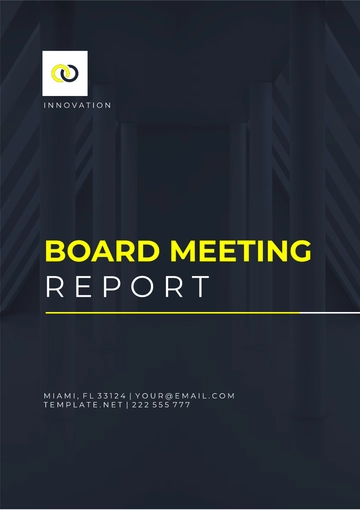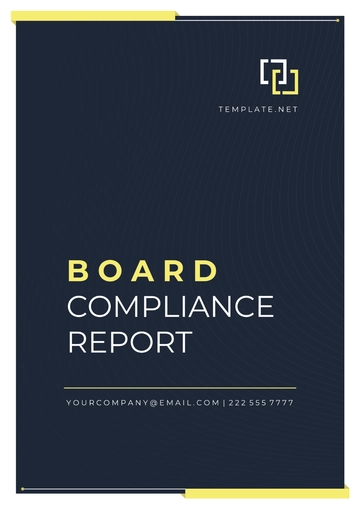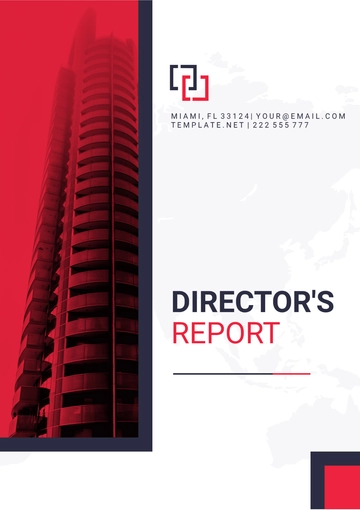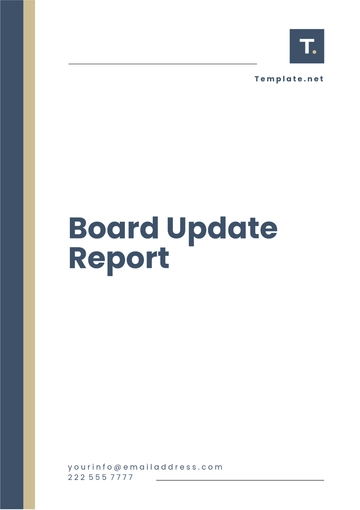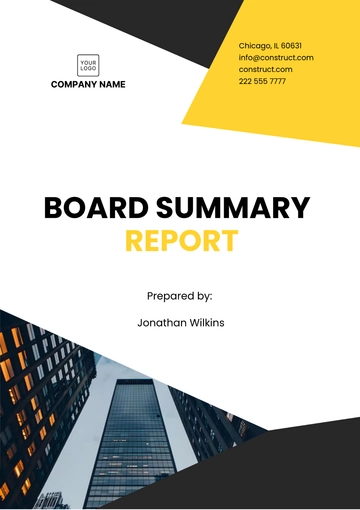Free Board of Director Compliance Report

I. Executive Summary
A. Purpose of the Report
The purpose of this report is to provide the Board of Directors with an overview of [Your Company Name]'s compliance status for the year 2050. The report covers regulatory compliance, risk assessments, internal controls, and any issues related to non-compliance. It aims to ensure the Board is fully informed about the company's adherence to legal requirements and overall governance.
B. Overview of Key Compliance Issues
This year, we faced challenges with data privacy regulations in several international markets, as well as evolving environmental laws. Additionally, changes in financial reporting standards required significant adjustments to our internal controls. These issues were addressed proactively through updates to company policies and compliance training programs.
C. Summary of Compliance Status
Overall, the company has maintained strong compliance with regulatory requirements. However, there were minor instances of non-compliance that were promptly addressed and corrected. The company continues to monitor compliance with emerging regulations to ensure long-term sustainability.
II. Regulatory Compliance Overview
A. Applicable Laws and Regulations
In 2050, [Your Company Name] is subject to a wide range of local and international regulations, including data protection laws, anti-money laundering standards, and environmental regulations. The primary regulatory frameworks include the Global Data Protection Regulation (GDPR), the International Anti-Corruption Act, and the Clean Energy Compliance Act. Compliance with these laws is critical to maintaining our operational licenses.
B. Changes in Regulatory Environment
This year, several new regulations came into effect, including enhanced data encryption standards under GDPR and stricter emissions reductions targets in the EU. Additionally, many countries introduced new requirements for transparent ESG (Environmental, Social, and Governance) reporting. We have taken steps to ensure that our processes align with these changes.
C. Key Compliance Areas and Focus
Our primary focus areas in regulatory compliance have been data privacy, environmental sustainability, and corporate governance. We have invested in advanced compliance technologies to improve monitoring and reporting. The company is also focusing on strengthening its supply chain compliance in line with new ethical sourcing guidelines.
III. Compliance Risk Assessment
A. Identification of Compliance Risks
The primary compliance risks identified this year include the potential for data breaches due to evolving cyber threats and the risk of non-compliance with new environmental regulations. These risks were categorized as high and medium, respectively, based on their potential impact on the organization.
B. Assessment of Risk Impact and Likelihood
The likelihood of a significant data breach was rated as medium, given the company's strong cybersecurity measures. However, the impact could be high if personal data of customers is compromised. Environmental regulation non-compliance is considered a medium risk, but could lead to reputational damage and fines.
C. Mitigation Strategies and Action Plans
To mitigate data breach risks, we implemented advanced encryption technologies and enhanced employee training on cybersecurity. For environmental risks, we have updated our sustainability programs and conducted an internal audit to ensure compliance with emission reduction targets. Regular risk assessments will be conducted to monitor these issues.
IV. Internal Controls and Procedures
A. Overview of Internal Compliance Framework
Our internal compliance framework is designed to ensure adherence to both regulatory requirements and company policies. This includes a centralized compliance team, regular audits, and a strong system of checks and balances across departments. Our framework is regularly reviewed to align with global best practices.
B. Key Compliance Policies and Procedures
The company’s key compliance policies include the Data Privacy Policy, the Anti-Corruption and Bribery Policy, and the Environmental Sustainability Policy. These policies are integrated into employee onboarding and ongoing training programs. All employees are required to acknowledge their understanding of these policies annually.
C. Evaluation of Effectiveness of Internal Controls
Internal controls are evaluated annually through both internal audits and third-party assessments. This year, audits showed a [00]% compliance rate with established controls. We also conducted a risk-based review of our financial reporting controls, leading to enhanced documentation procedures.
D. Results from Internal Audits and Assessments
Internal audits revealed two areas of concern related to outdated environmental reporting processes, which have since been addressed. All other key areas, including financial and data security controls, were found to be operating effectively. The audit team has recommended more frequent testing of compliance systems in high-risk areas.
V. Non-Compliance Issues
A. Instances of Non-Compliance
This year, there were two isolated instances of non-compliance. One occurred due to a late filing of a tax report in the EU, and the other was related to an environmental violation in our manufacturing division. Both issues were immediately rectified.
B. Details of Non-Compliance Events
The tax report delay was caused by an internal communication breakdown between departments. The environmental violation occurred due to a failure to meet waste disposal standards during a factory upgrade. Immediate corrective actions were implemented in both cases.
C. Impact Analysis
The impact of the tax filing delay was minimal, as no penalties were imposed. However, the environmental violation resulted in a fine of $[00] and necessitated additional training for the manufacturing team. Both issues were used as learning opportunities to improve future compliance.
D. Corrective Actions Taken
For the tax filing issue, we implemented an automated system to track and alert for tax deadlines. In response to the environmental violation, a new waste management protocol was introduced, and all employees in the division underwent retraining.
E. Ongoing Monitoring of Non-Compliance
We have implemented enhanced monitoring tools to track compliance with environmental and tax regulations. Regular compliance check-ins are scheduled to ensure all departments adhere to the updated procedures. The compliance team continues to monitor for potential non-compliance proactively.
VI. Compliance Training and Awareness
A. Overview of Training Programs
Our compliance training programs focus on data protection, anti-corruption measures, and environmental responsibility. All employees are required to complete mandatory training modules annually, with specialized training for high-risk departments. New hires undergo an intensive onboarding program that includes compliance training.
B. Employee Engagement and Compliance Awareness
Employee engagement with compliance programs has been strong, with an [00]% completion rate for mandatory training this year. We regularly survey employees to gauge their understanding of compliance policies. Feedback from employees helps shape future training initiatives.
C. Effectiveness of Training Programs
The effectiveness of our training programs is assessed through quizzes and scenario-based testing. This year, [00]% of employees passed the post-training assessments, indicating high levels of understanding. Additionally, compliance incidents related to policy violations have decreased by [00]% compared to last year.
VII. Compliance Reporting and Monitoring
A. Internal Reporting Mechanisms
Employees can report compliance concerns through a secure internal hotline or an anonymous online reporting system. All reports are investigated promptly, and appropriate action is taken. Regular updates on the status of investigations are shared with the Board.
B. Monitoring and Tracking Compliance Metrics
Compliance metrics are tracked through a centralized dashboard, allowing for real-time monitoring of key compliance indicators. Key metrics include training completion rates, audit results, and compliance incident reports. These metrics are reviewed by the compliance team and the Board quarterly.
C. Key Performance Indicators (KPIs) for Compliance
Key KPIs include
Percentage of compliance training completed
Number of non-compliance incidents
Audit findings and resolutions
Risk mitigation progress
KPI | 2050 Performance | Target for 2051 |
|---|---|---|
Training Completion Rate | 85% | 90% |
Non-Compliance Incidents | 2 | 0 |
Audit Findings Resolved | 100% | 100% |
D. Results from Ongoing Compliance Monitoring
Monitoring results show that compliance incidents have decreased by [00]% this year. Risk areas, such as cybersecurity and environmental compliance, continue to be prioritized. Monitoring systems are continuously improved to ensure more efficient tracking.
VIII. Governance and Oversight
A. Role of the Board in Compliance Oversight
The Board plays an active role in overseeing compliance efforts, meeting quarterly to review compliance reports and provide strategic direction. Board members are involved in the approval of key compliance policies and initiatives. Regular updates are provided to ensure full visibility into compliance efforts.
B. Board Involvement in Compliance Initiatives
This year, the Board approved the implementation of a new compliance management software to enhance reporting and monitoring. Additionally, Board members participated in a workshop focused on emerging risks in data privacy and environmental sustainability.
C. Interaction with External Auditors and Regulators
We maintain an open line of communication with external auditors, who conduct annual reviews of our compliance practices. Additionally, we actively engage with regulators in key jurisdictions to ensure we remain aligned with industry best practices. The external auditors have praised our compliance procedures.
IX. Recommendations for Improvement
A. Areas for Strengthening Compliance Framework
We recommend enhancing our environmental compliance training for high-risk divisions. Additionally, further investment in cybersecurity measures will be made to counter evolving threats. The company should also consider expanding its compliance team to handle increasing regulatory demands.
B. Suggestions for Enhancing Risk Mitigation
We propose implementing a company-wide risk assessment tool to improve the identification and mitigation of compliance risks. Regular cross-departmental workshops on compliance risks will also be scheduled. Enhanced collaboration with the IT department is necessary to strengthen data protection protocols.
C. Proposed Compliance Initiatives for the Coming Period
In the coming year, we aim to update our sustainability reporting procedures to meet new global standards. We also plan to implement a more comprehensive third-party due diligence program to ensure that suppliers meet our compliance standards. Additionally, compliance audits will be scheduled more frequently across departments.
X. Conclusion
A. Summary of Compliance Status
[Your Company Name] has made significant strides in maintaining compliance with all relevant regulations in 2050. While there were some isolated incidents of non-compliance, they were swiftly addressed, and corrective measures were implemented. The company's overall compliance program remains robust and proactive.
B. Future Compliance Strategy and Focus
Moving forward, the focus will be on strengthening environmental sustainability compliance, enhancing data protection measures, and addressing emerging regulatory challenges in global markets. Continued investment in training and technology will be key to maintaining a strong compliance culture.
C. Final Remarks and Next Steps
We remain committed to upholding the highest standards of compliance and governance. The Compliance Team will continue to monitor regulatory changes and ensure that [Your Company Name] is well-positioned to navigate future compliance challenges. The next Board meeting will review the progress on the 2050 compliance initiatives.
- 100% Customizable, free editor
- Access 1 Million+ Templates, photo’s & graphics
- Download or share as a template
- Click and replace photos, graphics, text, backgrounds
- Resize, crop, AI write & more
- Access advanced editor
Utilize the Board of Director Compliance Report Template from Template.net to streamline your compliance reporting process. Fully editable and customizable, this template allows you to tailor your report to your organization's specific needs. With the AI Editor Tool, crafting professional, accurate, and compliant reports has never been easier or more efficient. Perfect for corporate governance.
You may also like
- Sales Report
- Daily Report
- Project Report
- Business Report
- Weekly Report
- Incident Report
- Annual Report
- Report Layout
- Report Design
- Progress Report
- Marketing Report
- Company Report
- Monthly Report
- Audit Report
- Status Report
- School Report
- Reports Hr
- Management Report
- Project Status Report
- Handover Report
- Health And Safety Report
- Restaurant Report
- Construction Report
- Research Report
- Evaluation Report
- Investigation Report
- Employee Report
- Advertising Report
- Weekly Status Report
- Project Management Report
- Finance Report
- Service Report
- Technical Report
- Meeting Report
- Quarterly Report
- Inspection Report
- Medical Report
- Test Report
- Summary Report
- Inventory Report
- Valuation Report
- Operations Report
- Payroll Report
- Training Report
- Job Report
- Case Report
- Performance Report
- Board Report
- Internal Audit Report
- Student Report
- Monthly Management Report
- Small Business Report
- Accident Report
- Call Center Report
- Activity Report
- IT and Software Report
- Internship Report
- Visit Report
- Product Report
- Book Report
- Property Report
- Recruitment Report
- University Report
- Event Report
- SEO Report
- Conference Report
- Narrative Report
- Nursing Home Report
- Preschool Report
- Call Report
- Customer Report
- Employee Incident Report
- Accomplishment Report
- Social Media Report
- Work From Home Report
- Security Report
- Damage Report
- Quality Report
- Internal Report
- Nurse Report
- Real Estate Report
- Hotel Report
- Equipment Report
- Credit Report
- Field Report
- Non Profit Report
- Maintenance Report
- News Report
- Survey Report
- Executive Report
- Law Firm Report
- Advertising Agency Report
- Interior Design Report
- Travel Agency Report
- Stock Report
- Salon Report
- Bug Report
- Workplace Report
- Action Report
- Investor Report
- Cleaning Services Report
- Consulting Report
- Freelancer Report
- Site Visit Report
- Trip Report
- Classroom Observation Report
- Vehicle Report
- Final Report
- Software Report

